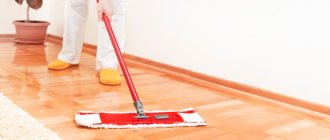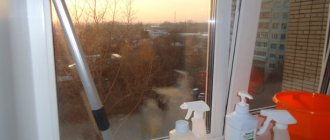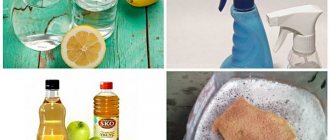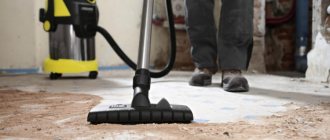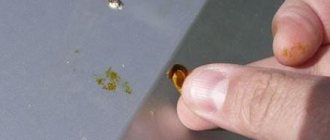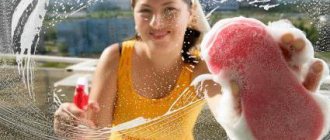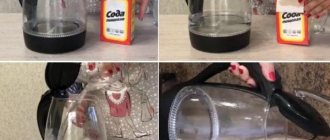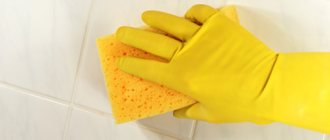Cleaning the floor after renovation
Cleaning the floor from dirt is often problematic, so cleaning has to be done several times.
The general algorithm for washing the floor is as follows:
- The first step is to use a regular soap solution, which must be applied to the surface and left for some time;
- Next, detergents suitable for the surface are used, and at this stage you need to make every effort to wipe off the dirt;
- Then the floor needs to be washed again, but now regular warm water will be used for this.
During the washing process, you need to ensure that the rag is relatively clean - do not smear dirt on the floor.
Sometimes after work, only stubborn dirt remains on the floor, which is difficult to clean. To solve this problem, you can use a folk remedy - add a little kerosene to the water. Its presence in the solution allows you to eliminate even the most serious stains.
Of course, using kerosene for cleaning floors also has a drawback - an extremely unpleasant and persistent odor. To get rid of it, you will need to wash the floor again, adding a glass of vinegar to the water - the smell will disappear completely.
If there are traces of whitewash or plaster on the floor, another method will be required. Before washing the lime off the floor, remove all solid residues that can be swept out with an ordinary broom. Next, the floor is cleaned using any dishwashing compound.
It will not be possible to completely remove all traces of whitewash using this method, so the next step is to wash the dirt with warm water and salt. The resulting mixture is one of the best answers to questions about how to wash floors after whitewashing.
If after this there are still stains on the floor, then you need to add a little potassium permanganate to a bucket of water, after which the composition will acquire a bright pink color. After washing the floor with this composition, the stains will disappear.
Washing floors after renovation - general recommendations
Sometimes it can be very difficult to clean the floors from accumulated dirt. You can't do it all at once. You will have to at least wash the floor in several stages. First, a soap solution is used, with which the surface is well wetted and left for some time. After this, special detergents are used. At the same time, you need to try to wipe off all the dirt. Now the floor is washed clean with warm water without any solutions or products. In order to clean the floor faster, you need to wash the rag as often as possible. Do not spread dirt over the entire surface.
Warm water with salt is perfect for cleaning whitewash or plaster floors.
In the event that there is only stubborn dirt on the floor, formed during the process of walking on it during work, you can use the folk method. To do this, you need to add a small amount of kerosene to the water. With its help, even the most stubborn dirt can be washed off without difficulty. Some will refuse this method because of the sharp and unpleasant smell of kerosene, but there is a way out. You just need to pour 200 ml of vinegar into a bucket of water and just wipe the floor clean. There will be no smell left at all.
Related article: Moss in the interior
If after repair there is whitewash or plaster left on the surface, you need to act differently. First of all, it is necessary to sweep and remove all remnants of whitewash. What remains must be washed with concentrated dishwashing detergent. All the whitewash will not be washed off in any case, so the next step is to use warm water with added salt. This will help quickly get rid of stubborn plaster stains. If the whitewash has been washed off, but stains from it still remain, you can try adding ordinary potassium permanganate to the water. She will quickly eat away all the stains. Its color should be bright pink.
Parquet cleaning
Before you wash the parquet after repair, you must first find out what type of contamination you are dealing with - the method of cleaning the surface will depend on this.
Common water-soluble dirt (putty, whitewash) can be removed with plain water and a small amount of detergent. That is why special preparation and long thoughts about how to wash putty from the floor are not required. In addition, the use of water to wash away dirt in the case of parquet is also justified for the reason that parquet is not afraid of moisture and is excellent for wet cleaning.
It will be much more difficult to deal with paint or glue that gets on the parquet.
Here you will have to use the following recommendations:
- Solvents are used to remove serious stains, but it is necessary to act with extreme caution: solvents can damage the top layer of parquet and thereby render it unusable;
- It is best to use soft compounds - white spirit, kerosene, methyl alcohol or substances for caring for stoves;
- To wash off dirt, a small amount of solvent is applied to the dirt and rubbed, and the sooner this is done, the easier it will be to remove the stain;
- Before eliminating contaminants, it is better to test how the solvent will act on a small, inconspicuous area of the coating.
We recommend: Water-heated floor under laminate
In addition to methods for washing dirt on parquet, you need to know what methods of exposure to this floor covering are prohibited:
- Parquet cannot be cleaned using rough brushes and metal scrapers: these devices can damage the varnish layer, thereby completely ruining the coating;
- When wet cleaning, you need to monitor the amount of water used: parquet can be washed, but an excessive amount of water can render it unusable;
- Detergents containing abrasive particles or aggressive solvents cannot be used to wash parquet flooring - its surface is not designed to withstand such loads.
Washing laminate
Laminate flooring, like any floor covering, is susceptible to various stains. Removing them can sometimes be problematic, but if you choose the right cleaning product, there won’t be any problems.
To decide how to clean laminate flooring after repairs, you need to understand what kind of dirt you will have to deal with.
Depending on the type of contamination, the laminate laundering process will look like this:
- If paint gets on the laminate flooring, the best way to remove it is with white spirit, which is well suited for such stains. A good option for a cleaning agent would be automotive chemicals, which can easily remove bitumen stains. Rubbing off paint should be done with soft materials - any abrasive agents will damage the surface of the laminate, so they should not be used.
- Sometimes during repairs foam gets on the floor. To scrub it off, Dimexide is used, which can be found in any pharmacy. First, the drug is applied to the stain, and after some time, the contamination is carefully removed with a sponge and spatula. You need to act very carefully so as not to damage the laminate.
- Sometimes after repairs, black characteristic marks left by shoes remain on the laminate. Water won't work here, but an eraser will. You just need to gently rub the stain to get rid of it completely.
In any case, after removing the dirt, the floor must be washed, using laminate cleaning products and a wrung out rag. After washing, there will be no stains or dirt left on the floor.
Cleaning various floor coverings after renovation
Washing the parquet
When washing parquet, it is strictly not recommended to use rough brushes or metal scrapers.
The process of washing after parquet repair will entirely depend on the nature of the contamination. If these are water-soluble materials, such as dirt, putty, whitewash, etc. Then you can deal with it using plain water with the addition of detergent. In this case, no serious action will be required. Parquet tolerates wet cleaning very well, so you don’t have to worry about damaging it.
During repairs, substances such as paint, glue, etc. may get onto the parquet. They are resistant to water, and in order to remove such stains, you need to try hard. You will have to use solvents. You should be very careful here, because some of them can damage the varnish layer and seriously damage the parquet. Therefore, it is necessary to choose substances that have only mild compositions. White spirit, methyl alcohol or kerosene are suitable for this. You need to pour a little product onto the stain and rub it well. It is best to do this with fresh paint that has not had time to dry. Such stains can also be cleaned with products designed to care for stoves. In order not to spoil the coating, it is better to first check how a particular substance will affect it, on an inconspicuous piece in the corner. Then everything will be preserved in its original form.
Related article: How to choose curtains on curtain tape
Regardless of how dirty the parquet is, it should never be rubbed with rough brushes or metal scrapers. This can only scratch the coating, thereby ruining it. In addition, you should remember that you do not need to wet it too much. Also, when cleaning, do not use cleaning products that contain abrasive particles or strong solvents. They will also have a negative impact on the parquet.
Cleaning laminate floors
Whitespirit is an ideal cleaning agent for laminate flooring after renovation.
No matter how carefully builders try to carry out repair work, even stains and dirt remain on laminate floors. Not all remedies will help in this case to cope with the problem. If paint gets on the laminate and small stains remain, it is best to use white spirit. It will most gently help remove this kind of contamination. In this case, you can also use auto chemicals, which serve as a means for removing bitumen stains. It is necessary to wipe off the paint only with a soft cloth, which will not damage the top protective layer of the laminate. It is simply unacceptable to use abrasive products here.
If there are black marks left on the laminate from shoes that cannot be washed off with plain water, you can wipe them off with a regular eraser. In addition, polyurethane foam may end up on the floor after repairs. The drug Dimexide, which is sold at the pharmacy, will help remove it. It is applied to the stain and left for a while, and then carefully removed with a spatula and sponge. This must be done with extreme caution. After removing all dirty and stubborn stains, all that remains is to wash the floor. To do this, you can use special laminate cleaning products and a well-wrung out cloth. In this case, there will be no divorces.
Washing linoleum
There are also always various traces of dirt on the linoleum that need to be eliminated. Washing linoleum is always carried out using clean warm water. In order to easily and efficiently wipe off all the dirt, you need to constantly change the rag - otherwise the floor will be covered with stains, which are later quite difficult to get rid of (read: “Painting a concrete floor in a garage”).
Soap is often added to water, which simplifies the process of washing linoleum. What you should not do is use soda - it has a negative effect on the surface of linoleum, significantly accelerating the process of fading.
If wet cleaning does not give the desired result, you can use one of the following methods:
- Turpentine is good for cleaning, allowing you to efficiently remove most contaminants;
- To eliminate large stains, you can use moistened chalk powder;
- Matte stains can be removed using a special mastic, which is available in many hardware stores (mastic can be replaced with linseed oil, which has a similar effect).
By choosing one of these methods before washing the lime off the floor, you can ensure that all contaminants are effectively and reliably removed.
General principles of parquet care
Parquet cannot boast the same resistance to abrasion and stains as, say, laminate, tile or linoleum. The safety of a parquet floor depends on its timely care.
To protect the parquet, several layers of transparent varnish are applied to it or the wood is impregnated with a special oil. During cleaning, especially wet cleaning, the varnish layer is gradually destroyed and the oil is washed out of the wood. It is better not to overuse wet cleaning; in addition to damaging the protective coating, it can also lead to warping of the parquet. Dust is also an implacable enemy of the varnish layer. Dust particles under the feet of those walking on the parquet act as an abrasive powder, stripping off the varnish layer. Over the course of a few years, especially when walking, it wears out and completely collapses, forming unsightly “paths.” In this case, the floor will have to be scraped and the coating renewed. It is better to clean such rooms with a broom and vacuum cleaner.
Oil impregnation lasts longer and protects the wood more reliably. This protection also reacts poorly to wet cleaning. A wet rag or mop will leave light streaks on the floor. Impregnation must be repeated once every 1-2 years.
Don't start the parquet
Another traditional way to protect and care for a parquet floor is to rub it with wax mastic. It gives the parquet a fresh look and a pleasant shine, but it has to be repeated every week.
If you leave the parquet floor, it will become covered with mud stains and gray spots, which will be quite difficult to clean.
How to wash whitewash?
The most difficult thing is to wash whitewash from the floor covering. In order to effectively get rid of white stains, you need to frequently change the water and rinse the rag or mop well. You can effectively get rid of traces of whitewash using such folk remedies.
| Whitewash remover | How to act correctly? |
| Rock salt + vinegar | The first time you should wash the floor with clean water, then take new water into a bucket and pour five tablespoons of rock table salt into it. Salt water is great for getting rid of whitewash marks. To finish cleaning, wash the floors with a weak solution of table vinegar. |
| Sunflower oil + vinegar |
|
| Potassium permangantsovka |
But this product cannot be used on surfaces that are varnished, as stains will remain . |
| Kerosene | Whitewash that has already dried well on the floor covering can be washed with kerosene. To do this you need:
|
We recommend: Natural linoleum
How to clean floor tiles after renovation
Method 1
The following homemade bleaching agent will whiten the seams between the tiles, and also refresh the tiles themselves:
- Prepare 10 cups of water in a deep enough container, as the mixture may react and rise for a while;
- Add ½ cup of soda and 1/3 cup of lemon juice to it;
- Pour in ¼ cup vinegar;
- Mix, put on gloves and wash the tile floor with the solution.
Method 2
Ideally washes tiles after repair from dust, dirt, glue, as well as those contaminated over time with Stork Sanox gel.
- Put on gloves, apply the gel to the sponge, and then to the tile;
- The action of the product is immediate, so you can wash it off almost immediately with clean water and enjoy the result.
Method 3
It will not be difficult to wash off construction dust from the tiles. Water with lemon or vinegar, glass cleaner, and even ordinary soapy water will perfectly clean and add shine. But the adhesive solution, especially a dried one, is more difficult to deal with. First you need to soften it.
- Moisten the adhesive stains on the tiles with a mixture of water and vinegar, or water and ammonia (you can also use acetone, after testing it on a small area to avoid the risk of damaging the tiles);
- The softened glue can be scraped off with a stiff sponge or scraper.
Method 4
The hardened primer can be washed off with acetone, or you can purchase a special remover that includes a solvent. The principle of operation is similar to the previous option.
- Apply solvent or acetone to the primer stains;
- Once they have softened, remove them with a glass scraper.
Method 5
You can get rid of acrylic primer from tiles in this way:
- Wet a towel and place it on the stained surface;
- Keep it moist for several hours by sprinkling with water;
- Once the soil has swelled, it can be gently cleaned with Pemolux and rinsed off with clean water.
Method 6
Paint stains on tiles can be easily removed with products such as Mole, Pufas Abbeizer or regular acetone. As an option - liquid glass. When it turns into a film, it is easy to peel off along with the paint.
Method 7
Cement residues on tiles can be removed using Atlas Szop, Milizid, or an effective mixture of vinegar, citric acid and Domestos.
It is much easier to remove any contamination immediately after it gets on the tiles, before it hardens.
Method 8
If you don't know how to clean grout from tile floors, experiment with the following methods and products, keeping in mind that smooth glazed tiles can be cleaned well with a dry cloth, followed by water and detergent. Matte glazed – with an acid-containing substance.
- A mixture of oxalic acid and water washes the grout;
- Table vinegar, can be diluted with water;
- Acid-containing substances will help, for example, “Deterdek”, “Litoclean”;
- Cleaning product "Cinderella";
- You should try gasoline, acetone, and white spirit.
How to clean plaster from a floor after renovation
As a rule, gypsum plaster is most often used, followed by cement. Gypsum plaster hardens quickly, so it should be washed off the floor as soon as possible. In fact, gypsum is chalk, so all of the above methods of washing whitewash from the floor will help. Chemical agents are also effective, for example, “Atlas Szop”, “Plitonit wash”. Additionally, try removing gypsum plaster using the following method:
- Remove large pieces of plaster with a wooden or plastic spatula;
- Clean the floor with a dry cloth;
- Dampen the cloth and place it over the plaster stains;
- When the plaster gets wet, it can be washed with vinegar or oil, as is the case with floors after whitewashing.
We recommend: How to treat floorboards
Cement plaster is removed in the following ways:
- Pour acetic acid onto the cement stains;
- 5-10 minutes after it dissolves, wipe off the residue with a dry cloth.
Concrete cleaners and solvents will also help: “Lepta Himfrez”, “Lugato Zementschleierentferner”, “Bio Decap' Beton Guard”.
How to remove traces of plaster from the floor
Remove drops of dried plaster mechanically. Use a spatula or similar tool. Try to remove most of the material dry. Wash off any remaining residue with soapy water, a suitable detergent, or a solvent that is safe for the specific type of floor covering.
First check the cleaning solution for compatibility with the material. Apply the selected product to an inconspicuous area of the floor, leave for 5 minutes and rinse. If the texture and color have not changed, use it for cleaning. Once the plaster is removed, rinse the surface with clean water.
Recommendations:
- Gypsum plaster sets in 1-1.5 hours, remove traces as quickly as possible. Use a cloth soaked in water to moisten large, dry stains. When they soften, wash the plaster with vinegar or oil solutions.
- Remove cement plaster with acetic acid. Dampen the dirt and wipe off the residue with a dry microfiber after 10-15 minutes. Solvents and concrete cleaners are effective against cement-based mixtures.
Start cleaning from the far corner, gradually moving towards the exit. Thoroughly clean cracks, grooves, baseboards, and corners.
Parquet cleaning
Parquet flooring does not tolerate caustic substances and excess moisture. Remove large debris using a vacuum cleaner with a soft attachment. For wet cleaning of parquet or parquet boards, use cleaning products (according to the instructions). Highly effective concentrates designed to thoroughly, intensively clean oiled or waxed surfaces. Work with soft rags that quickly absorb water - microfiber cloths.
Cleaning procedure:
- Prepare the solution following the instructions. Apply to contaminated areas.
- To dissolve and soften contaminants, rub the composition over the surface with a soft brush or cloth.
- In a maximum of 10 minutes. Carefully remove any remaining product with a rag.
- Rinse the coating with fresh water.
Do not use abrasives, hard brushes or scrapers.
How to remove dirt from plaster from laminate flooring
Wash the floor with soapy water, then with water. Do not over-wet the laminate; work with a well-wrung out cloth or mop. You can use other non-aggressive detergents: shower gel, shampoo, dishwashing detergent. To avoid streaks, use microfiber.
Removing marks from linoleum
Remove large dirt with a vacuum cleaner.
Cleaning from plaster:
- For stubborn stains, use gasoline, turpentine or kerosene. Apply it locally - to the area of contamination - wash off after 5-7 minutes.
- Prepare a solution of vegetable oil and water (1:100). Dampen a rag and wipe the stain. Take a bucket of water, add 250 ml of vinegar. Rinse the floor a second time and wash it clean.
- Take salt and dishwashing gel. Dissolve 20-30 ml of product in a bucket and clean. For the second approach, use water and 150 g of salt. Finally, rinse the linoleum with warm water.
After completing the work, wipe the floor dry. Do not use too hot water, alcohol, or aggressive agents.
Cleaning tiles from plaster
Before washing, clean the tiles with a vacuum cleaner and wipe with a dry cloth. Remove large pieces of mortar with a spatula (plastic or wooden). Do not use a metal tool - it will leave scratches even on durable ceramics.
Recommendations:
- Use a plumbing and oven cleaner to remove remaining stains. Wash the floors with a brush 2-3 times, remove the contaminated solution with a rag.
- If there are a lot of stains and the cladding area is large, use tile foam. It is sold among cleaning chemicals and in construction stores.
- At the last stage, wash the tile surface with acidified water. Dissolve 2 cups of vinegar in 10 liters of water.
Change the water and cloth frequently when washing. Wipe the cleaned floor dry. Treat the tiles with drain cleaner (anti-streak). Do not use products with chlorine or strong acids.
How to clean linoleum after repair
The vast majority of tips presented on how to clean a floor after renovation, depending on what exactly it was contaminated with, are effective in this matter. But, in the case of linoleum, it is important to consider the following points:
- Do not use soda, alkali and other abrasive substances so as not to scratch the coating or make it brittle;
- Do not wash linoleum with too hot water;
- When cleaning linoleum, avoid using alcohol, including ammonia;
- Apply gasoline, turpentine, kerosene only to stains, or better yet;
- Always test even the most vaunted product on a small and inconspicuous area of linoleum. Otherwise, there is a risk that the design will be washed off and the coating will become rough.
How to clean laminate flooring after renovation
Cleaning a floor after renovation with installed laminate is perhaps the most difficult thing to do. In general, it is advisable to cover the laminate floor with thick film or other material before repairs, attaching it to the edges with double-sided tape. The fact is that the protective film of the laminate coating is thin - a few microns. Although it is durable, a large amount of dust and constant movement on it lead to scratches. They can no longer be removed by anything, and the scratched laminate will never be the same. You can remove dust and stains, but it is impossible to restore the smoothness of the protective film.
Before you begin wet cleaning of laminate flooring, you should try to remove dust as much as possible. Use a vacuum cleaner several times to remove debris and dust particles, grains of sand from all cracks and gaps. There are some stains from mortar, you can try to remove them with a plastic spatula (available in hardware stores). Stains that are small in size and volume can be easily cleaned off with an old plastic card. It is elastic enough and at the same time not too hard to cause serious damage to the laminating film.
A plastic putty knife or old plastic card is the best way to remove mortar stains.
When cleaning wet, use only slightly damp cloths. The ingredients are still the same: water with vinegar, salt. But this time we take a little water (one and a half liters) and it should be hot - 80-90°C. Pour vinegar (50 grams) into it, add a pinch of salt, stir everything. Wet a rag/mop in the solution and quickly wipe the floor. While the solution is hot, it evaporates quickly. Dries almost instantly. At the final stage - to wash the laminate without streaks - add a little sunflower oil to clean water.
How to clean laminate floors after renovation
Laminate flooring today occupies a leading position. This is a beautiful, durable and expensive coating, so it’s difficult to resist noticing that before repair work it is very important to take proper care of it and protect it from contamination. But, if a mistake has already occurred, the following tips will help eliminate the problem.
Method 1
If the laminate is stained with paint, alcohol, white spirit or acetone will help to remove it:
- Remove large debris, vacuum small debris;
- Apply the product to a cotton swab and treat the stain;
- Wipe the treatment area with a damp cloth.
Important: laminate floors are washed with a minimum amount of water. After washing, wipe dry to avoid swelling and deformation of the joints.
Method 2
Dirt and dust are easily washed off with dishwashing detergent added to water. You only need to use soap suds or wring out the rag as thoroughly as possible. If there are stains, you can wash the floor with water with vinegar added to it (for 10 liters of water - 1 glass of vinegar).
Method 3
Splashes of whitewash on a laminate floor can be removed with window cleaner, after which the floor is wiped with a soft cloth. Also effective in this case are vegetable oil, salted water and a vinegar solution.
I wash the varnished floor after renovation
How to clean a floor after renovation if the coating is varnished? Try the following processing options.
- Oil paints on the floor are treated with white spirit. The main thing is to apply the product directly to the stain. After treatment, the floor is thoroughly washed and wiped with a damp cloth soaked in a solution of 10 parts water and 1 part glycerin;
- A mixture of 5 liters of water and ½ cup of salt will help remove whitewash or plaster. The composition cleans the floor well without leaving marks or streaks;
- Also, the varnished floor is washed with a mixture of 5 liters of water, 0.5 tsp. potassium permanganate and 1 tbsp. vegetable oil.
- Special cleaners for varnish coatings are used: “Bona Wood Floor Cleaner”, “IRSA Aqua Star R9”.
How to clean the floor after renovation: tiles, laminate, linoleum, parquet
Renovating one room in a residential apartment is perhaps the worst thing imaginable. But this is exactly what you often have to do. Already in the process of repair, no matter how hard you try to create less dust, dust lies in a thin layer everywhere, floating in the air. To minimize damage, try to keep the furniture covered with film or cloth at all times. They can then be washed/washed; cleaning furniture is more difficult. But the most tedious thing is to clean the floor after renovation, even if only dust has leaked into the rooms and there are no stains. No matter how much I wash it, it still appears again, again and again on the floor, with a white coating on all surfaces. We will tell you further how to solve the problem, how and with what to clean the floor after repair.
How to clean floors after renovation without streaks
- Laundry soap will help eliminate stains on linoleum floors. A small amount of it is added to water, which should be changed very often, and the rag should be constantly rinsed and squeezed thoroughly;
- Laminate floors are washed with warm water and vinegar. The acid evaporates moisture, so there are no streaks left on the washed floor;
- Marble floors are not washed with soap or powder; it is best to use only warm water, adding a product with a neutral pH, for example, InterChem 501.
- When washing a tiled floor, ammonia, citric acid, vinegar essence, and window cleaner are added to the water.
- A mixture of water with the addition of a small amount of kerosene and table salt gets rid of stains on the floor.
How to clean the floor after renovation?
How to wash or clean concrete dust? To cope with such a difficult task as quickly as possible, you will need the following tools:
- water container;
- several rags;
- microfiber cloths;
- vinegar;
- salt;
- potassium permanganate;
- ammonia;
- kerosene;
- dishwashing detergent;
- Domestos;
- LOC Liquid Organic Cleaner from Amway;
- special floor cleaning products Mister Muscle and Mister Proper;
- laminate and parquet care products, for example, Laminate wash & shine;
- tile care products, for example, HG “Polish, wax and dirt remover”;
- Acidic floor cleaner DETERDEK.
In a separate article you will find a more detailed selection of suitable cleaning products after renovation.
